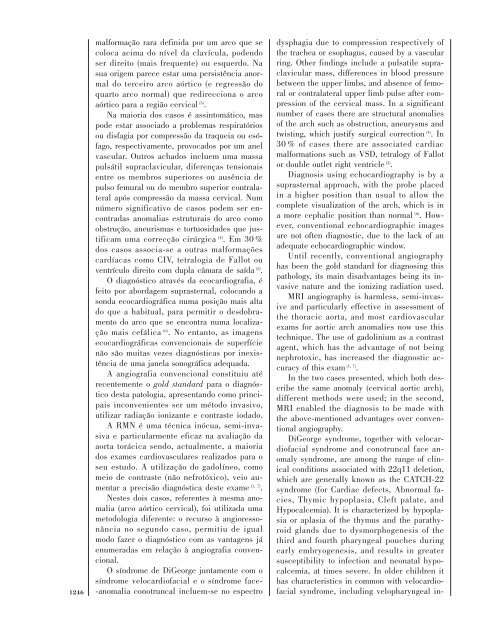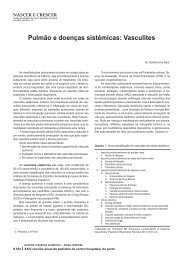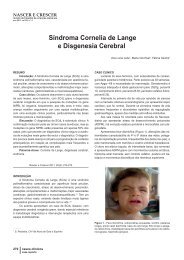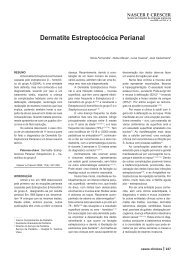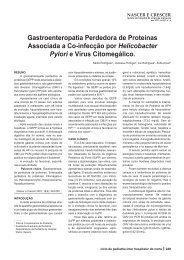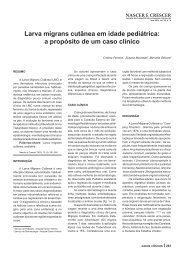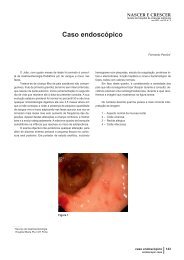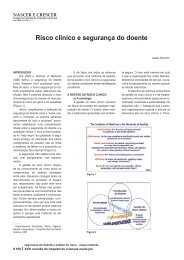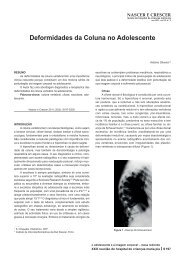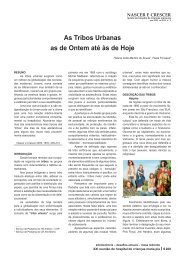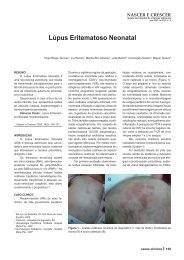Associação de Arco Aórtico Cervical.pdf
Associação de Arco Aórtico Cervical.pdf
Associação de Arco Aórtico Cervical.pdf
Create successful ePaper yourself
Turn your PDF publications into a flip-book with our unique Google optimized e-Paper software.
1246<br />
malformação rara <strong>de</strong>finida por um arco que se<br />
coloca acima do nível da clavícula, po<strong>de</strong>ndo<br />
ser direito (mais frequente) ou esquerdo. Na<br />
sua origem parece estar uma persistência anormal<br />
do terceiro arco aórtico (e regressão do<br />
quarto arco normal) que redirecciona o arco<br />
aórtico para a região cervical (3) .<br />
Na maioria dos casos é assintomático, mas<br />
po<strong>de</strong> estar associado a problemas respiratórios<br />
ou disfagia por compressão da traqueia ou esófago,<br />
respectivamente, provocados por um anel<br />
vascular. Outros achados incluem uma massa<br />
pulsátil supraclavicular, diferenças tensionais<br />
entre os membros superiores ou ausência <strong>de</strong><br />
pulso femural ou do membro superior contralateral<br />
após compressão da massa cervical. Num<br />
número significativo <strong>de</strong> casos po<strong>de</strong>m ser encontradas<br />
anomalias estruturais do arco como<br />
obstrução, aneurismas e tortuosida<strong>de</strong>s que justificam<br />
uma correcção cirúrgica (4) . Em 30 %<br />
dos casos associa-se a outras malformações<br />
cardíacas como CIV, tetralogia <strong>de</strong> Fallot ou<br />
ventrículo direito com dupla câmara <strong>de</strong> saída (5) .<br />
O diagnóstico através da ecocardiografia, é<br />
feito por abordagem suprasternal, colocando a<br />
sonda ecocardiográfica numa posição mais alta<br />
do que a habitual, para permitir o <strong>de</strong>sdobramento<br />
do arco que se encontra numa localização<br />
mais cefálica (6) . No entanto, as imagens<br />
ecocardiográficas convencionais <strong>de</strong> superfície<br />
não são muitas vezes diagnósticas por inexistência<br />
<strong>de</strong> uma janela sonográfica a<strong>de</strong>quada.<br />
A angiografia convencional constituiu até<br />
recentemente o gold standard para o diagnóstico<br />
<strong>de</strong>sta patologia, apresentando como principais<br />
inconvenientes ser um método invasivo,<br />
utilizar radiação ionizante e contraste iodado.<br />
A RMN é uma técnica inócua, semi-invasiva<br />
e particularmente eficaz na avaliação da<br />
aorta torácica sendo, actualmente, a maioria<br />
dos exames cardiovasculares realizados para o<br />
seu estudo. A utilização do gadolíneo, como<br />
meio <strong>de</strong> contraste (não nefrotóxico), veio aumentar<br />
a precisão diagnóstica <strong>de</strong>ste exame (1, 7) .<br />
Nestes dois casos, referentes à mesma anomalia<br />
(arco aórtico cervical), foi utilizada uma<br />
metodologia diferente: o recurso à angioressonância<br />
no segundo caso, permitiu <strong>de</strong> igual<br />
modo fazer o diagnóstico com as vantagens já<br />
enumeradas em relação à angiografia convencional.<br />
O síndrome <strong>de</strong> DiGeorge juntamente com o<br />
síndrome velocardiofacial e o síndrome face-<br />
-anomalia conotruncal incluem-se no espectro<br />
dysphagia due to compression respectively of<br />
the trachea or esophagus, caused by a vascular<br />
ring. Other findings inclu<strong>de</strong> a pulsatile supraclavicular<br />
mass, differences in blood pressure<br />
between the upper limbs, and absence of femoral<br />
or contralateral upper limb pulse after compression<br />
of the cervical mass. In a significant<br />
number of cases there are structural anomalies<br />
of the arch such as obstruction, aneurysms and<br />
twisting, which justify surgical correction (4) . In<br />
30 % of cases there are associated cardiac<br />
malformations such as VSD, tetralogy of Fallot<br />
or double outlet right ventricle (5) .<br />
Diagnosis using echocardiography is by a<br />
suprasternal approach, with the probe placed<br />
in a higher position than usual to allow the<br />
complete visualization of the arch, which is in<br />
a more cephalic position than normal (6) . However,<br />
conventional echocardiographic images<br />
are not often diagnostic, due to the lack of an<br />
a<strong>de</strong>quate echocardiographic window.<br />
Until recently, conventional angiography<br />
has been the gold standard for diagnosing this<br />
pathology, its main disadvantages being its invasive<br />
nature and the ionizing radiation used.<br />
MRI angiography is harmless, semi-invasive<br />
and particularly effective in assessment of<br />
the thoracic aorta, and most cardiovascular<br />
exams for aortic arch anomalies now use this<br />
technique. The use of gadolinium as a contrast<br />
agent, which has the advantage of not being<br />
nephrotoxic, has increased the diagnostic accuracy<br />
of this exam (1, 7) .<br />
In the two cases presented, which both <strong>de</strong>scribe<br />
the same anomaly (cervical aortic arch),<br />
different methods were used; in the second,<br />
MRI enabled the diagnosis to be ma<strong>de</strong> with<br />
the above-mentioned advantages over conventional<br />
angiography.<br />
DiGeorge syndrome, together with velocardiofacial<br />
syndrome and conotruncal face anomaly<br />
syndrome, are among the range of clinical<br />
conditions associated with 22q11 <strong>de</strong>letion,<br />
which are generally known as the CATCH-22<br />
syndrome (for Cardiac <strong>de</strong>fects, Abnormal facies,<br />
Thymic hypoplasia, Cleft palate, and<br />
Hypocalcemia). It is characterized by hypoplasia<br />
or aplasia of the thymus and the parathyroid<br />
glands due to dysmorphogenesis of the<br />
third and fourth pharyngeal pouches during<br />
early embryogenesis, and results in greater<br />
susceptibility to infection and neonatal hypocalcemia,<br />
at times severe. In ol<strong>de</strong>r children it<br />
has characteristics in common with velocardiofacial<br />
syndrome, including velopharyngeal in-


